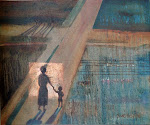The huge and heavy (up to 30 tons each) Chinese puzzle shaped concrete forms that are frequently seen heaped together to form breakwaters in many parts of the world were originally designed by a South African harbour engineer, Eric Merrifield.
After a 1963 storm on the Eastern Cape coast severely damaged East London’s harbour, Merrifield wondered if the breakwater suffered so much damage because it was solid and took the full force of the water on just one plane. He decided to reconstruct the breakwater using a "porous" design to dissipate the water's energy.
He based his design on the shape of the bones used in the 1830s by Voortrekker (Afrikaans) children when playing the game called "knucklebone", which were similar in shape to jacks that are tossed in child's play (shaped like the letter "H" with one leg turned 90 degrees.) Because these bone toys were sometimes thought of as imaginary oxen, they were called dolosse (literally dumb oxen”.)
It was so successful and cost effective that, being free of patents, the design is now used on coastlines around the world. Dolosse have reached new limits recently, with the casting of the biggest dolosse on the African continent for the deepwater Port of Ngqura outside Port Elizabeth,which forms part of the Coega Industrial Development Zone, still under construction. 26 500 dolosse weighing 30 tons apiece are used in the main breakwater which, at 2.5 kilometres long, is the largest in Africa.
Sadly, in PE, much of the land along our beautiful shoreline of sandy beaches was taken over by the Railways, and a large portion reclaimed for use by the rail and road network to the bay.
although, as you can see here, in severe gales and spring tides, it does still wash over the main N2 freeway that runs parallel to the railway lines.
Fishermen still love this spot, but have to run the gauntlet of power cables for the electric trains!
Here is a picture taken about 10 years ago, while Port St Francis small craft harbour was being constructed, beginning in early 1996 and successfully completed towards the end of 1997. In the area that has since been hollowed out to form the yacht basin, dolosse were being manufactured, and moved to form what is now the harbour wall and peninsula. I dealt with that construction in some detail in a past post.
As we find ourselves blissfully relaxing at the Port again this weekend, I snapped some more shots of them now that the harbour is so well established.
These dolosse are 15 tons each and when you see how huge they are, it will give you an idea of how impressive the Coega ones are!
It is hard to give an idea of how huge these hunks of concrete are, but if you look at the curving harbour wall next to them, it is too high for even a very tall person to look over. To take photos over the top, one stands on a 60cm high platform.
Seeing the waves lapping gently around them this morning, it is hard to imagine that, when we were here last March,
we were unable to walk on the harbour wall because the spring tides were so high that the waves were crashing right over the top!

Bear in mind that this breakwater is taller than a two storey building, and you begin to get an idea of the massive erosive forces these dolosse breakwaters have to resist, year after year!
And, of course, they do make interesting silhouettes on sunrise photos……..
And seagulls find them handy to perch on!
(if all this engineering stuff interests you, and you haven’t slipped into a coma from boredom yet, the engineers report and construction drawings of the port at St Francis are available here.)

























6 comments:
Really interesting post-also the sky watch, slowly catching up and recovering
New Steam post up now.
I recently started visiting your blog and I enjoy it immensely. Thank you for sharing.
Oh yes... here in Portugal we have some beaches that have a lot of them too.
I used to live in a city called Espinho (near Porto) that has two buig ones.
Wow....these are great shots! Absolutely adore the last one with the seagull!
A great read for a Sunday afternoon, the pictures are stunning and the story behind them is very informative.. I real enjoyed this post.
Max and I were laughing about this post yesterday, people coming to this middle aged granny's blog could be forgiven for expecting crochet patterns and the latest recipes, instead, in the space of a couple of weeks, there have been tall ships, various aircraft, feats of engineering and smashed traffic lights and the odd rant about this 'n that!... well at least you never quite know what to expect when you visit here, which makes life exciting!! :)
Post a Comment